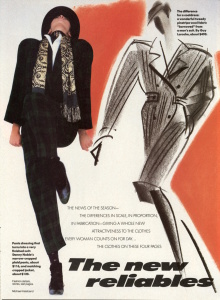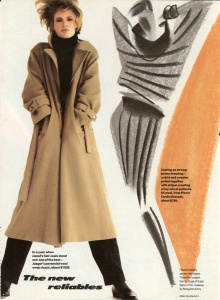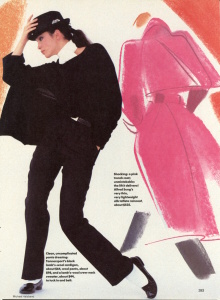- Joined
- Jul 24, 2010
- Messages
- 79,183
- Reaction score
- 43,960

I think it's happened over time… one thing I've done with photography is combined it with all other interests I have had in my life to experience or explore them to a greater depth and I think now, it's just come down to photography. – Michael Halsband
Born and raised in New York City, Michael Halsband started photography as a hobby at age ten. At school, almost by chance, he was shown how to make a print from start to finish. Amazed by this process, he ran home and announced to his parents "I'm into photography". They said, "If you're into photography in a year, we will buy you a camera". For a year, Halsband happily printed old family snapshots in the darkroom and understood that true creation takes place there. For him, every step in photography serves getting into the darkroom. As a teen, Halsband attempted to gain admission to The School of Visual Arts with his drawings & paintings. The head of admissions was not impressed with Halsband's work and asked if he had anything else to show. The next day, Halsband came back with his photography and was immediately accepted into the school.
While attending SVA in 1978, Halsband began professionally photographing portraits for magazine stories and covers. By his third year at SVA, he made enough money to buy his own studio. Some of the people he photographed at that time were: Andy Warhol, Bernice Abbott, David Byrne, Walter Stedding, Glenn Branca, Alan Vega, Bob Guccione, Klaus Nomi and Lydia Lunch and Eight Eyed Spy. Klaus Nomi's portrait was made in February of 1980, and was part of Halsband's senior thesis. Klaus showed up with the space-like outfit that had just been made by a costume designer. Nomi wanted Halsband to be the first to photograph him in that outfit because he loved Halsband's relentless attention to detail. After graduating from SVA in the spring of 1980, he and continued to work for magazines like Interview, Avenue and Rolling Stone, making portraits including Jim Carroll and Peter Tosh.
In summer of 1981, after several weeks on the road photographing James Brown, Halsband got an assignment to photograph Keith Richards for the cover of Rolling Stone Magazine and consequently was asked by Mick Jagger to be The Rolling Stones tour photographer. Upon returning to New York City, he continued pursuing a career in fashion; something he had already been working toward during his time at SVA. He began working for Condé Nast which featured his work in GQ, Self, Vogue, House and Gardens, Glamour and Mademoiselle. In 1985, Halsband created his most iconic photograph, which became the poster of Andy Warhol and Jean-Michel Basquiat with boxing gloves for their collaborative exhibition. Halsband spent the next seven years photographing fashion and portraits for various magazines; making album covers for Iggy Pop, The Psychedelic Furs, INXS, Deee-Lite; worked on international ad campaigns for Gap and J.Crew, and created press kits for many designers including Calvin Klein and Adrian Vittadini. Throughout the entire experience, Halsband remained humble. He says;
"My heroes [are] sociologists and archaeologists; people who study our cultures – [they] all inspired me to flatten the whole thing and take the glamour out of it…It's about more than just famous people, since every photo sitting has to be on level ground, with no one having the upper hand. When I'm photographing, it is about letting what is: be…"
In 1986 Halsband began working on what would become a six-year project, underwritten by Danskin, photographing the School of American Ballet. Ballet was not something that initially interested Halsband, but he thought it was very intimate and high-action. It had to be the perfect movement in its perfect moment, in the perfect light; those were Halsband and SAB's standards. In 1991, he transitioned away from the SAB project into another five-year personal project on nudes and portraits of strippers and sex industry workers. He found there was a lot of repression within nude photography and wanted to be honest in his work. Over time, the sitters would come with their own clothing, slowly peeling them off, and revealing their own fantasies. It became self-portraiture on both sides of the camera.
In 1994, Halsband was hired directly by Al Pacino to document the making of his film, "Looking for Richard". That same year he began working with The Rolling Stones once again on their "Voodoo Lounge" tour. Additionally, after years of letter writing to the band's manager, Halsband was hired to photograph the promotions and advertising for one of his favorite bands: AC/DC. Consequently, he covered their entire Ball Breaker Tour from 1995-1996. In 1999, Halsband traveled to Cuba with Hunter S. Thompson and Johnny Depp for Rolling Stone magazine to document the trip. As a result, Halsband was written into Thompson's book, "Kingdom of Fear". In 2000, Halsband got the opportunity to work with AC/DC for a second time on their world tour: Stiff Upper Lip, while continuing to photograph album covers and direct music videos. In 2002, Halsband became a Hasselblad Master and became the recipient of the Telly Award for a TV commercial he directed entitled "Family Shot" for Neil Diamond's new record.
In summer of 2005, Halsband released a book entitled Surf Book. He began working on this project with surf legend Joel Tudor in 1999. The goal was to document the most technologically and spiritually influential people in surf culture. In addition to capturing still images of surf culture, Halsband began working on a surf film. The film, entitled "Surf Movie: Reels 1-14" released in 2003, was immediately embraced by the art world. The film has been shown in galleries and museums since its release. Additionally, a new surf film shot between 2002-2004 is currently in post-production. Since 2006, Halsband has been making portraits of artists, musicians, surfers and friends in his studio with an 8x10 Camera. Inspired by his daily yoga practice, and eastern philosophy he wanted to see the result from stripping away all pretense, and posturing on both sides of the camera, in attempt to achieve a pure portrait. The courage to do allow what is to be is the intention. Personally processing and printing his work is part of the tradition. "I think it's happened over time… one thing I've done with photography is combined it with all other interests I have had in my life to experience or explore them to a greater depth and I think now, it's just come down to photography"
In Spring 2011 a series of Halsband's Andy Warhol and Jean-Michel Basquiat portraits were included in an exhibit at the Warhol Museum, followed by an exhibition at the Arken Museum in Denmark, featuring a twelve foot reproduction of the Portrait of the two artists with arms crossed wearing boxing gloves. Quiksilver Womens commisioned him to shoot and direct a series of short films with four time world champion Surfer, Stephanie Gilmore titled "The Water Dancer". He paired Stephanie with three Dancers from various disciplines, with the intention to explore the connections between surf and dance. At the same time he began shooting and directing a short documentary film about the Peconic Land Trust, and the programs they have created for young aspiring farmers, to be shown in the summer 2012. Halsband has been always open to alternative exhibition ideas and spaces. In the summer he and graphic designer, Timothy Hsu collaborated on a show of current portraits in a unique environment, Mandarin's Tea Room in Soho, NY combining another practice that supports Halsbands work, Tea.
"Tea will put you in the right frame of mind... open up feelings, allow for the viewer to be receptive to something. Our eyes can be deceptive. I tend to want to believe in the heart to heart moment. It is a connection you have with that person, one to one and no two are alike". This show will continue through 2012.
michaelhalsband.com













































